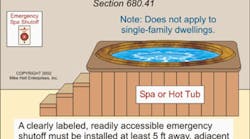Note: The following Code references are from the 2002 NEC.
Q. If it's not possible to locate the maintenance disconnect 5 feet from the equipment, could it be located within the hot tub assembly behind closed panels?
A.No, the hot tub maintenance disconnect (680.12) must be located not less than 5 feet horizontally from the inside walls of an outdoor spa or hot tub, unless separated by a solid fence, wall, or other permanent barrier [680.22(C)].
In other than a “single-family dwelling,” a clearly labeled emergency spa or hot tub water recirculation and jet system shutoff must be provided. It must be readily accessible to the users and located not less than 5 feet away, but adjacent to and within sight of the spa or hot tub (680.41) (Figure at right).
The emergency shutoff is meant to protect users. Deaths and injuries have occurred in less than 3 feet of water when individuals became stuck to the water intake opening. This requirement applies to spas and hot tubs installed indoors as well as outdoors.
Q. I have a wall switch that's no longer needed. I'd like to remove the switch, cap the wires, and replace the switch plate with a blank one. Is this OK or must I remove the abandoned wires?
A. The NEC doesn't require the removal of abandoned power and lighting conductors, just abandoned low-voltage and limited wiring. It's a good idea to disconnect the unused wires from their power source, but this isn't a Code requirement.
Q. I have a cord-and-plug connected outdoor spa/hot tub motor that uses a GFCI-protected cord. The attachment plug is rated 15A and not of the twist-lock type. Where can I locate the receptacle?
A. Outdoor spas must be wired in accordance with the same requirements as a permanently installed pool (680.42). Since the receptacle for the spa or hot tub will be of the non-twist lock type, the receptacle must be located not less than 10 feet from the inside walls of the outdoor spa or hot tub [680.22(A)(1)].
Note: All 15A and 20A, 125V receptacles located within 20 feet of the spa or hot tub must be GFCI-protected [680.22(A)(5)], and all 15A and 20A, 125V receptacles located outdoors of a dwelling unit must be GFCI-protected [210.8(A)(1)].
Q. Is there a section in the Code that restricts the use of extension cords?
A. No. The NEC is an installation standard, not a product standard. However, listed extension cords should be used in accordance with the listed instructions, but this isn't a Code requirement. According to UL's Web site, extension cords aren't intended to be used as a substitute for the fixed wiring of a structure. So basically, an extension cord is only for temporary usage.
Q. I'm working on a job where a drinking water fountain is proposed to be installed within 1 foot of a transformer. Is there a Code rule that governs the necessary clearance between the drinking fountain and the transformer?
A. Yes. According to 110.26, you must provide sufficient step-back working space from energized parts, measured from the enclosure front, that are no less than the distances shown in Table 110.26(A)(1). Assuming this is a 480V to 208V transformer, the minimum step-back working space according to this table is 3.5 feet. The water fountain/cooler can be located right next to the transformer sides as long as the transformer ventilating openings aren't blocked (450.9).





